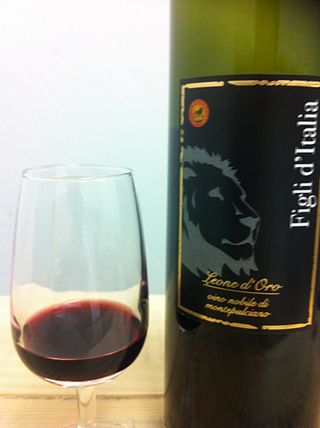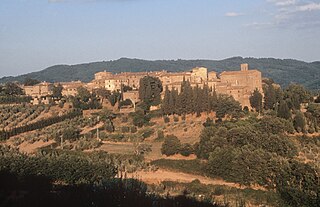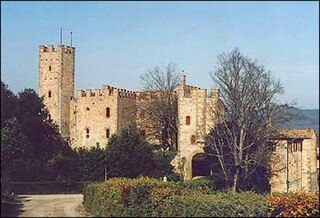
Chianti is an Italian red wine produced in the Chianti region of central Tuscany, principally from the Sangiovese grape. It was historically associated with a squat bottle enclosed in a straw basket, called a fiasco. However, the fiasco is now only used by a few makers of the wine; most Chianti is bottled in more standard-shaped wine bottles. In the latter nineteenth century, Baron Bettino Ricasoli helped establish Sangiovese as the blend's dominant grape variety, creating the blueprint for today's Chianti wines.

Montalcino is a hill town and comune in the province of Siena, Tuscany, central Italy.

The province of Siena is a province in the Tuscany region of Italy. Its capital is the city of Siena.

Brunello di Montalcino is a red DOCG Italian wine produced in the vineyards surrounding the town of Montalcino, in the province of Siena, located about 80 km south of Florence, in the Tuscan wine region. Brunello, a diminutive of bruno, is the name that was given locally to what was believed to be an individual grape variety grown in Montalcino. In 1879 the province of Siena's Amphelographic Commission determined, after a few years of controlled experiments, that Sangiovese and Brunello were the same grape variety, and that the former should be its designated name. In Montalcino the name Brunello evolved into the designation of the wine produced with 100% Sangiovese.

Italian wine is produced in every region of Italy. Italy is the country with the widest variety of indigenous grapevine in the world, with an area of 702,000 hectares under vineyard cultivation, as well as the world's second largest wine producer and the largest exporter as of 2023. Contributing 49.8 million hl of wine in 2022, Italy accounted for over 19.3% of global production, ahead of France (17.7%) and Spain (13.8%); the following year, production decreased by 11.5 million hl, and Italy was surpassed by France. Italian wine is also popular domestically among Italians, who consume a yearly average of 46.8 litres per capita, ranking third in world wine consumption.

Greve in Chianti is a town and comune (municipality) in the Metropolitan City of Florence, Tuscany, Italy. It is located about 31 kilometres (19 mi) south of Florence and 42 kilometres (26 mi) north of Siena.

Vino Nobile di Montepulciano is a red wine with a denominazione di origine controllata e garantita status produced in the vineyards surrounding the town of Montepulciano, Italy. The wine is made primarily from the Sangiovese grape varietal, blended with Canaiolo Nero (10%–20%) and small amounts of other local varieties such as Mammolo. The wine is aged for 2 years ; three years if it is a riserva. The wine should not be confused with Montepulciano d'Abruzzo, a red wine made from the Montepulciano grape in the Abruzzo region of east-central Italy.

Sovicille is a comune (municipality) in the Province of Siena in the Italian region Tuscany, located about 60 kilometres (37 mi) south of Florence and about 10 kilometres (6 mi) southwest of Siena.

Marchesi Antinori Srl is an Italian wine company, based in Florence, Tuscany, that can trace its history back to 1385. They are one of the biggest wine companies in Italy, and their innovations played a large part in the "Super-Tuscan" revolution of the 1970s.
Engineer Filippo Fiorentini founded the Fiorentini & C. S.p.A. factory of excavators in 1919 in Rome, Italy. He imported and distributed construction equipment. During the time of Fascism, restrictions banned import and Ing. Fiorentini started his manufacturing plant in Via Tiburtina near Stazione Tiburtina for the construction of excavators such as scrapers/draglines and cranes under the license of an American company named Bucyrus.

Tuscan wine is Italian wine from the Tuscany region. Located in central Italy along the Tyrrhenian coast, Tuscany is home to some of the world's most notable wine regions. Chianti, Brunello di Montalcino and Vino Nobile di Montepulciano are primarily made with Sangiovese grape whereas the Vernaccia grape is the basis of the white Vernaccia di San Gimignano. Tuscany is also known for the dessert wine Vin Santo, made from a variety of the region's grapes. Tuscany has forty-one Denominazioni di origine controllata (DOC) and eleven Denominazioni di Origine Controllata e Garantita (DOCG). In the 1970s a new class of wines known in the trade as "Super Tuscans" emerged. These wines were made outside DOC/DOCG regulations but were considered of high quality and commanded high prices. Many of these wines became cult wines. In the reformation of the Italian classification system many of the original Super Tuscans now qualify as DOC or DOCG wines but some producers still prefer the declassified rankings or to use the Indicazione Geografica Tipica (IGT) classification of Toscana. Tuscany has six sub-categories of IGT wines today.

Gaja is an Italian wine producer from the Piemonte region in the district of Langhe, chiefly producing a number of Barbaresco and Barolo wines, and later diversified into Brunello di Montalcino and "Super Tuscan" production. Its current owner and president Angelo Gaja is credited with developing techniques that have revolutionised winemaking in Italy, and terms such as "the undisputed king of Barbaresco", and "the man who dragged Piedmont into the modern world" have been applied to him, and whose Barbaresco wine is considered a status symbol on a par with Château Lafite Rothschild or Champagne Krug.

Castello di Volpaia is a winery located in the medieval village of Volpaia. The estate spans over 900 acres, divided between vineyards, olive groves, and woods. The winery is organically farmed, producing extra virgin olive oil, vinegar, and wine, particularly Chianti Classico. The winery is owned by Carlo and Giovannella Mascheroni Stianti, who are assisted by their son Nicolo Mascheroni Stianti.

The history of Chianti dates back to at least the 13th century with the earliest incarnations of Chianti as a white wine. Today this Tuscan wine is one of Italy's most well known and recognizable wines. In the Middle Ages, the villages of Gaiole, Castellina and Radda located near Florence formed as a Lega del Chianti creating an area that would become the spiritual and historical "heart" of the Chianti region and today is located within the Chianti Classico Denominazione di Origine Controllata e Garantita (DOCG). As the wines of Chianti grew in popularity other villages in Tuscany wanted their lands to be called Chianti. The boundaries of the region have seen many expansions and sub-divisions over the centuries. The variable terroir of these different macroclimates contributed to diverging range of quality on the market and by the late 20th century consumer perception of Chianti was often associated with basic mass-market Chianti sold in a squat bottle enclosed in a straw basket, called fiasco.

The castle of Montalto lies east of Siena, Italy, in an area known as ‘la Berardenga’, which is an extensive territory in the Chianti region of Tuscany. Its position right on the border between the territories of Siena and Florence gave it great strategic importance during the 13th, 14th and 15th centuries. Much of the castle is from medieval times and parts date back to 1000 or earlier; extensive restorations were performed in the 16th century and again in the 19th century.

Batignano is a small town in southern Tuscany, a frazione of the comune of Grosseto, positioned at about 10 km north-east of the capital on one of the last foot-hills of the valley of Ombrone which dominated the ancient city of Roselle.

Montenero d'Orcia is a village in Tuscany, central Italy, administratively a frazione of the comune of Castel del Piano, province of Grosseto, in the area of Mount Amiata. At the time of the 2001 census its population amounted to 253.

I Balzini D'Isanto is a wine estate in Italy, producing a Super Tuscan (wine), classified IGT, an official Italian classification designating the region of origin, rather than grape varieties or wine styles, allowing the use of foreign grape varieties to be added. The estates is owned by the D'Isanto family since 1980. The name "I Balzini" comes from the word "balze", the local name for the small terraces planted with vines.














